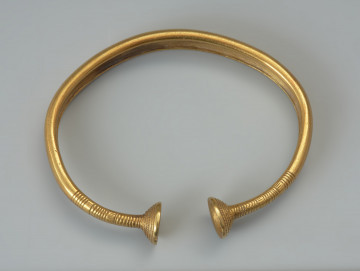
Horse bit cheekpiece (bit shank)
około 1600 p.n.e. — 1500 p.n.e.
National Museum in Szczecin
Part of the collection: Bronze Age
This indistinct object ranks among some unique archaeological finds. It is a button with two circular heads, on the slightly convex underside of which one hole each has been drilled, horizontally in relation to the body of the item. Remarkably, the texture of the carefully polished top surface resembles the mother of pearl covering shells. From the very beginning of the exploration, this fact intrigued the researchers, who subjected the artefact to microscopic and chemical examinations as well as zoological consultations. As a result, it turned out that it was made from the tusks (sabres) of a boar, or more precisely from their front part covered with enamel. The relic was found accidentally in 1887 in a peat surface, at a depth of 1 m. It was found there together with an ornate shield and two sets of bronze buzzers and four corresponding buttons, which regrettably have not been preserved to date. This treasure is dated to the 5th period of the Bronze Age, i.e. the years around 900-750 BC. Among published archaeological sources, no similar fastenings have yet been encountered in the area of central and northern Europe. However, we are fortunate that almost identical buttons have recently turned up in another of the Pomeranian treasures. The discovery was made quite by accident in 2014 in the village of Wąwelnica near Szczecin. The general view holds that this type of extremely rare buttons made of animal bones or teeth originated in the remote Alpine region, in the area of the pile dwellings inhabited by the local factions of the Lusatian culture. Indeed, so far, this is the only region where finds of similar buttons have been attested. Dorota Kozłowska
Other names
Doppelknopf
Author / creator
Object type
costium adorment, button (fastener)
Technique
cutting
Material
boar lower canin
Origin / acquisition method
legal transfer
Creation time / dating
Creation / finding place
Owner
Muzeum Narodowe w Szczecinie
Identification number
Location / status

około 1600 p.n.e. — 1500 p.n.e.
National Museum in Szczecin

around 900 p.n.e. — 750 p.n.e.
National Museum in Szczecin

around 900 p.n.e. — 750 p.n.e.
National Museum in Szczecin
DISCOVER this TOPIC
National Museum in Szczecin
DISCOVER this PATH
Educational path